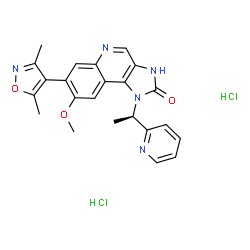I-BET 151 dihydrochloride
Modify Date: 2025-08-27 12:42:52

I-BET 151 dihydrochloride structure
|
Common Name | I-BET 151 dihydrochloride | ||
|---|---|---|---|---|
| CAS Number | 1883545-47-8 | Molecular Weight | 488.366 | |
| Density | N/A | Boiling Point | N/A | |
| Molecular Formula | C23H23Cl2N5O3 | Melting Point | N/A | |
| MSDS | N/A | Flash Point | N/A | |
Use of I-BET 151 dihydrochlorideI-BET151 dihydrochloride (GSK1210151A dihydrochloride) is a BET bromodomain inhibitor which inhibits BRD4, BRD2, and BRD3 with pIC50 of 6.1, 6.3, and 6.6, respectively[1][2]. |
| Name | I-BET 151 hydrochloride |
|---|---|
| Synonym | More Synonyms |
| Description | I-BET151 dihydrochloride (GSK1210151A dihydrochloride) is a BET bromodomain inhibitor which inhibits BRD4, BRD2, and BRD3 with pIC50 of 6.1, 6.3, and 6.6, respectively[1][2]. |
|---|---|
| Related Catalog | |
| Target |
pIC50: 6.1 (BRD4), 6.3 (BRD2), 6.6 (BRD3)[1] |
| In Vitro | I-BET151 dihydrochloride (1 μM; 72 hours) treatment displays the majority of live cells resided in the G0 phase and commensurate with a dose- and time-dependent decrease in cell proliferation and abrogation of bromodeoxyuridine incorporation[2]. I-BET151 dihydrochloride (100 nM; 72 hours) causes a significant dose- and time-dependent decrease in the proportion of myeloma cells in S/G2 phase[2]. Cell Viability Assay[2] Cell Line: H929 cells Concentration: 1 μM Incubation Time: 72 hours Result: Displays the majority of live cells resided in the G0 phase and commensurate with a dose- and time-dependent decrease in cell proliferation and abrogation of bromodeoxyuridine incorporation. Cell Proliferation Assay[2] Cell Line: H929 cells Concentration: 100 nM Incubation Time: 72 hours Result: Caused a significant dose- and time-dependent decrease in the proportion of myeloma cells in S/G2 phase. |
| In Vivo | I-BET151 dihydrochloride demonstrates low blood clearance in the rat (~20% liver blood flow) and good oral systemic exposure which resulted in good oral bioavailability. High clearance is observed in the dog (~95% liver blood flow). The systemic exposure in the dog is low, resulting in a poor oral bioavailability of 16%. The high blood clearance in dog correlates well with the high intrinsic clearance observed in dog microsomes and hepatocytes, whereas the low intrinsic clearances seen in rat and mouse (mouse IVC 1.6 mL/min/g; CLb 8 mL/min/kg) correlate with lower in vivo blood clearances in these species. Due to the low systemic exposure observed in the dog, I-BET151 dihydrochloride is investigated in the mini-pig as a potential second species for toxicological evaluation where it showed low clearance (~32% liver blood flow) and good bioavailability (65%)[1]. I-BET151 dihydrochloride (30 mg/kg; i.p.; daily for 21 days)-treats mice has four- to five fold smaller myeloma tumors and a significantly reduces rate of tumor size doubling than vehicle-treated mice[2]. Animal Model: Mice (model of subcutaneous myeloma)[2] Dosage: 50 mg/kg Administration: I.p.; daily for 21 days Result: Reduced rate of tumor size doubling than vehicle-treated mice. |
| References |
| Molecular Formula | C23H23Cl2N5O3 |
|---|---|
| Molecular Weight | 488.366 |
| Exact Mass | 487.117798 |
| Hazard Codes | T+ |
|---|
| 2H-Imidazo[4,5-c]quinolin-2-one, 7-(3,5-dimethyl-4-isoxazolyl)-1,3-dihydro-8-methoxy-1-[(1R)-1-(2-pyridinyl)ethyl]-, hydrochloride (1:2) |
| 7-(3,5-Dimethyl-1,2-oxazol-4-yl)-8-methoxy-1-[(1R)-1-(2-pyridinyl)ethyl]-1,3-dihydro-2H-imidazo[4,5-c]quinolin-2-one dihydrochloride |